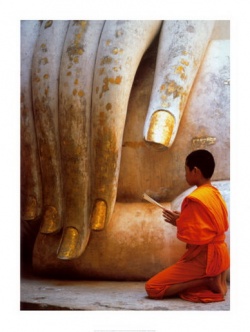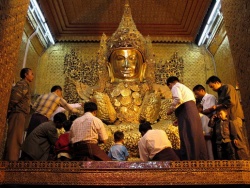Mind Training (Lojong)
An anthology of lojong texts created through the inspiration and guidance of Alak Zenkar Rinpoche.
Texts on so-called mind training" (blo sbyong), the system of practical instructions for developing the compassion and wisdom of bodhicitta:
Seven Points of Mind Training
Seven Points of Training the Mind According to the Great Vehicle by Geshe Chekhawa Yeshe Dorje
One of the most important and influential works of mind training composed in Tibet, this series of slogans was first composed—that is, written down—by Chekawa Yeshe Dorje (1101–1175) according to the tradition of Atiśa Dīpaṃkara (982–1055?). The seven points cover: 1) the preliminaries, 2) main practice, 3) transformation of adversity, 4) life-long application of the practice, 5) measures of progress, 6) commitments, and 7) precepts.
Ambrosia for the Mind by Jamyang Khyentse Wangpo
Jamyang Khyentse composed this prayer for perfecting the Seven Points of Mind Training (blo sbyong don bdun ma) when he was in the presence of the famous Atiśa statue at the Tārā Temple in Nyethang (snye thang). The section headings were added by Dilgo Khyentse Rinpoche.
Eight Verses of Training the Mind
Eight Verses of Training the Mind by Geshe Langri Thangpa
These eight verses, which are now regularly transmitted around the world by the Fourteenth Dalai Lama, succinctly convey the compassionate attitude, humility and uncompromising vision of a true bodhisattva—as encapsulated in the text's most famous and most striking lines: "I will take defeat upon myself and give the victory to others.
Thirty-Seven Practices
The Thirty-Seven Practices of All the Bodhisattvas by Gyalse Tokme Zangpo
One of the most famous native Tibetan texts on mind training, this classic by Tokme Zangpo summarises the teachings of Śāntideva's Bodhicaryāvatāra and other sources, in order to present the path of the bodhisattva in just thirty-seven four-line verses.
Parting from the Four Attachments
Nectar of the Heart—An Experiential Song of Parting from the Four Attachments by Jamyang Khyentse Wangpo
This experiential song (nyams dbyangs) based on 'Parting from the Four Attachments' (zhen pa bzhi bral) was composed in the cave of Rangjung Dorje, where Mañjuśrī is said to have delivered the original teaching to the Sakya patriarch Sachen Kunga Nyingpo (1092–1158).
Parting from the Four Attachments by Jetsün Drakpa Gyaltsen
Drakpa Gyaltsen's famous commentary on the four-line instruction that his father, Sachen Kunga Nyingpo, received from Mañjuśrī, is so closely associated with the root text that it is often known by the same title, Parting from the Four Attachments.
Nubpa Rigdzin Drak's Parting from the Four Attachments by Nubpa Rigdzin Drak
Little is known about the author, Nubpa Rigdzin Drak, who may have been a student of Jetsün Drakpa Gyaltsen (1147–1216), but his commentary is among the best known works on Parting from the Four Attachments—partly as a result of its inclusion in the Blo sbyong brgya rtsa compendium. The text explains the antidotes to each of the four attachments and the results that will accrue from applying them.
The Instructions on Parting from the Four Attachments spoken by Mañjuśrī to Sachen Kunga Nyingpo
This famous four-line teaching was spoken by Mañjuśrī, who appeared in a vision to the young Sachen Kunga Nyingpo during a six-month retreat. It is said to encapsulate the entire bodhisattva path of the pāramitās.
Sakya Pandita’s Instruction on Parting from the Four Attachments by Sakya Pandita
A brief commentary on Parting From the Attachments (zhen pa bzhi bral), the famous four-line instruction originally revealed by Mañjuśrī to Sachen Kunga Nyingpo (1092-1158), Sakya Paṇḍita's great uncle.
Lojong (general)
The Bodhisattva’s Garland of Jewels by Atiśa Dīpaṃkara
This short text—Bodhisattvamaṇyāvalī in Sanskrit—is regarded as a classic work of the Mind Training (blo sbyong) tradition. With its direct and pithy language, it is not so much a poem as a series of maxims on the bodhisattva path.
The Blissful Path to the Ocean of Bodhichitta]]: A Brief Prayer of Aspiration for Mind Training by Dilgo Khyentse Rinpoche
This prayer of aspiration for training the mind in bodhicitta by exchanging all the world's suffering for genuine happiness is based on Jamgön Kongtrul Lodrö Thaye's longer text, The Gateway to the Ocean of Bodhicitta.
Turning Suffering & Happiness Into Enlightenment by Dodrupchen Jigme Tenpe Nyima
One of Jigme Tenpe Nyima's best known works—and indeed one the most famous Tibetan texts of recent times—this is a pithy and practical guide to integrating all experiences, good and bad, happy and sad, into the path to enlightenment. As the text itself puts it, this is “indispensable for leading a spiritual life, a most needed tool of the Noble Ones, and quite the most priceless teaching in the world.”
The Sayings of Geshe Langri Tangpa by Geshe Langri Thangpa
Taken from a collection called Miscellaneous Sayings of the Saintly Masters of the Kadam Tradition (bka' gdams kyi skyes bu dam pa rnams kyi gsung bgros thor bu ba rnams]]) edited by the 11th/12th century teachers Chegom Sherab Dorje (lce sgom shes rab rdo rje) and [[Kharak Gomchung Wangchuk Lodrö (kha rag sgom chung dbang phyug blo gros).
How to Transform Sickness and Other Circumstances by Gyalse Tokme Zangpo
This is a classic work on 'bringing difficult circumstances onto the path' (lam khyer), a subgenre of mind training. Tokme Zangpo reveals what it is like to live beyond hopes and fears, and how to face sickness, poverty and death (as well as good health, prosperity and long-life) with joy.
Thirty Pieces of Heart Advice by Longchen Rabjam
Longchen Rabjam tells us that he composed these thirty verses of heartfelt advice for himself and others like him, out of a sense of renunciation. In what has become one of his most famous and popular teachings, he advocates simplicity, ethical discipline, humility, and, above all, diligent practice.
Aspiration to Generate Bodhicitta, Utterly Pure and Supreme by Patrul Rinpoche
This prayer of aspiration covers the entire Buddhist path, but places special emphasis on the cultivation of bodhicitta in its various forms. For to have bodhicitta, says Patrul Rinpoche, is to have "all that's needed to attain enlightenment."
Three Principal Aspects of the Path by Tsongkhapa
One of the great Tsongkhapa Lobzang Drakpa's most famous teachings, this short text highlights the importance of renunciation, the motivation of bodhicitta, and the wisdom that realises the nature of things.






